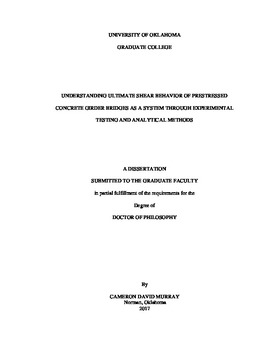| dc.contributor.advisor | Floyd, Royce | |
| dc.contributor.author | Murray, Cameron | |
| dc.date.accessioned | 2017-07-19T18:01:38Z | |
| dc.date.available | 2017-07-19T18:01:38Z | |
| dc.date.issued | 2017-07 | |
| dc.identifier.uri | https://hdl.handle.net/11244/51831 | |
| dc.description.abstract | A prestressed concrete bridge is a complex system. The interconnectivity of several girders, a deck, and secondary elements such as diaphragms makes their behavior difficult to represent. Additionally, the shear behavior of in service prestressed concrete girders can be difficult to predict, particularly when older codes were used in design and where damage is present in the girders. This work contains laboratory testing to investigate the residual shear performance of two older American Association of State Highway and Transportation Officials (AASHTO) Type-II prestressed concrete girders, as well as the behavior of a scale prestressed concrete bridge loaded in shear to failure. The full-scale girders were found to be capable of carrying their full capacity even when corrosion affected the failure mechanism. Based on these tests, the modified compression field theory (MCFT) methods were recommended for estimating the capacities of older girders. The scale bridge provided information about load distribution at ultimate capacity, and the influence of secondary elements (diaphragms) on load transfer after girder failures. The bridge test also documented the ultimate behavior of a prestressed concrete bridge, findings that are not common in the literature. The bridge failure was controlled by punching shear, and the diaphragms were seen to provide a significant means of load transfer after a girder failed. Finally, simple computer models were built that are capable of reducing the conservativism of the codified distribution factor (DF) methodology, increasing the usable capacity of bridges. These models simplify the girders and slab into a “grillage” of beam elements with appropriate stiffnesses. A parametric study suggests that for AASHTO Type-II girder bridges, load ratings tend to be conservative for smaller girder spacing and shorter span lengths. Code DFs were generally found to be conservative for all configurations of typical Type-II girder bridges. | en_US |
| dc.language | en_US | en_US |
| dc.subject | Prestressed Concrete | en_US |
| dc.subject | Bridges | en_US |
| dc.subject | Shear | en_US |
| dc.subject | Bridge Modeling | en_US |
| dc.title | UNDERSTANDING ULTIMATE SHEAR BEHAVIOR OF PRESTRESSED CONCRETE GIRDER BRIDGES AS A SYSTEM THROUGH EXPERIMENTAL TESTING AND ANALYTICAL METHODS | en_US |
| dc.contributor.committeeMember | Ramseyer, Christopher | |
| dc.contributor.committeeMember | Volz, Jeffery | |
| dc.contributor.committeeMember | Harvey, P. Scott | |
| dc.contributor.committeeMember | Holliday, Lisa | |
| dc.date.manuscript | 2017-07 | |
| dc.thesis.degree | Ph.D. | en_US |
| ou.group | College of Engineering::School of Civil Engineering and Environmental Science | en_US |
| shareok.orcid | 0000-0003-4488-3469 | en_US |
